
SHOOTOUT: Originally posted June 11th, 2007 by rob-ART
morgan, mad scientist Many of you have emailed us asking which 15" MacBook Pro "Santa Rosa" we recommend, the 2.2GHz model with 128MB of GDDR3 video SDRAM or the 2.4GHz model with 256MB of GDDR3 video SDRAM. In other words, at least for 3D accelerated Gaming, is the 2.4GHz model worth the extra $500 for a 9% faster CPU clock speed and more video memory? We ran four different 3D accelerated games at 1280x800 and 1920x1200. As of June 12th, we added the 17" MacBook Pro 2.4GHz "Santa Rosa" model, too. Here's what we measured: GRAPH LEGEND (Red is fastest at each resolution) ANALYSIS We were pleasantly surprised to see the 17" MacBook Pro 2.4GHz ran as much as 11% faster than the 15" model. Though they have the same GeForce 8600M GT, you can see by the table below that the 17" model clocks up to higher frequencies than the 15" model. CORE CLOCK and MEMORY CLOCK SPEEDS of 8600M vs X1600 THE COST/BENEFIT EQUATION WHEN DO I NEED MORE VRAM? It was suggested that we test the 3D games at "Ultra" Quality in Doom 3 and Quake 4 to see if that creates a bigger gap between the 128M and 256M models. We also plan to try enabling 4X FSAA to see what impact that has. HOW WE TESTED WORLD OF WARCRAFT RELATED ARTICLES See our "CPU Crunching" article comparing the "Santa Rosa" MacBook Pro to other Apple laptops running Photoshop CS3, After Effects CS3, Compressor 3, and Motion 3. COMING SOON WHERE TO BUY YOUR MACBOOK PRO "Santa Rosa" or other Apple products You can also purchase Apple systems and accessories from Small Dog Electronics. You can custom order from them just like with the Apple Store. WHERE TO BUY MEMORY FOR MAC LAPTOPS TransIntl.com is selling kits to take your "Rosa" MacBook Pro to 4GB. They also have kits to take your 13" MacBook to 3GB. Other World Computing sells various kits for the MacBook and MacBook Pro. They have done extensive testing with the 13" MacBook to see what gain is made from matching pairs -- including dual 2GB modules. Has Bare Feats helped you? How about helping Bare Feats? © 1995 - 2007 Rob Art Morgan
MacBook Pro 2.2 versus 2.4
(and 128M versus 256M VRAM)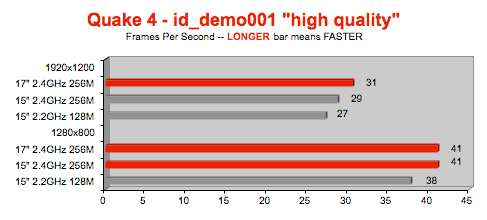
We used the MP aware 1.3 patch to run Aspyr Quake 4.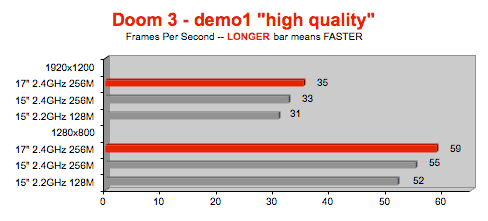
We ran version 1.3.1 of Aspyr Doom 3.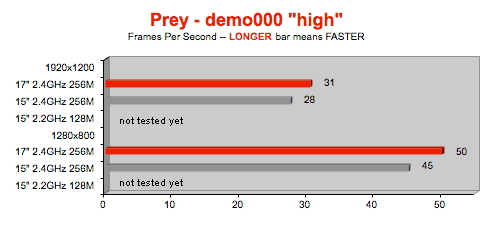
Aspyr Prey is our newest 3D gaming benchmark. It uses the Doom 3 engine. We are currently using a timedemo file we downloaded from Overclockers in Australia. (You can download it by clicking HERE.)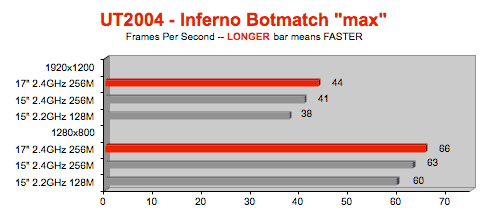
We used the SantaDuck Standard Bench Ver. 3 to test Unreal Tournament, build 3369.2.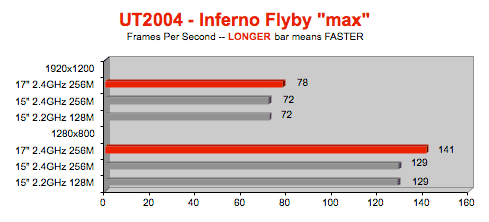
While the Botmatch stresses CPU more than GPU, the Flyby test is almost pure GPU.
See notes below on how we tested World of Warcraft: The Burning Crusade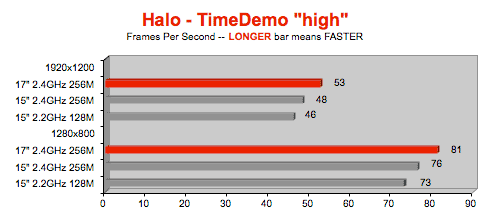
We tested Halo UB 2.0.2 using all the best settings except Lens Flare was set to "low" and FSAA was "off."
(See description below of how we tested World of Warcraft: Burning Crusade)
17" 2.4GHz 256M = 17" MacBook Pro "Santa Rosa" 2.4GHz Core 2 Duo with 256MB of GDDR3 SDRAM video memory and 2GB of DDR2 main memory
15" 2.4GHz 256M = 15" MacBook Pro "Santa Rosa" 2.4GHz Core 2 Duo with 256MB of GDDR3 SDRAM video memory and 2GB of DDR2 main memory
15" 2.2GHz 128M = 15" MacBook Pro "Santa Rosa" 2.2GHz Core 2 Duo with 128MB of GDDR3 SDRAM video memory and 2GB of DDR2 main memory
12x8 = 1280x800 (to represent a typical gaming resolution)
19X12 = 1920x1200 (native to the 17" but possible on the 15" using an external 23" Apple Cinema display with MBP lid closed)
The 15" MacBook Pro 2.4GHz Core 2 Duo (256MB GDDR3 video SDRAM) was at most 9% faster than the 15" 2.2GHz MacBook Pro (128MB GDDR3 video SDRAM). If we average all the results, it was 5% faster. Suspiciously, that 9% maximum gap corresponds to the 9% difference between the 2.2GHz and 2.4GHz Core 2 Duo CPU clock speeds. At least for graphics intensive apps like 3D accelerated games, it can be argued that the extra video memory doesn't buy you anything.
In case you weren't aware, the core and memory clock speeds of the MacBook Pro's GPU are variable, depending on what you are doing. Though there is currently no Mac OS X utility to measure this on the newest laptops, we were able to confirm the frequencies of the newest MacBook Pros using ATITool under Windows XP Pro:
Radeon X1600
GeForce 8600M
GeForce 8600M
Core Clock idle
Core Clock normal
Core Clock max
Memory Clock idle
Memory Clock normal
Memory Clock max
* Video memory is double data rate so you multiply the speed times 2. In the case of the 8600M GT in the 17" MacBook Pro, the top memory speed is 650 x 2 = 1300MHz
As for price difference between the "good" and "better" 15" MacBook Pro, it's more accurate to say $425 instead of $500 if you configure both the 2.2 and 2.4GHz models identically (with the same 160GB 5400rpm drive). So you have to ask yourself, is the 9% maximum performance advantage worth 20% more money? And how much is that 9% advantage worth in terms of your time savings over the life of the machine? And which of the two models will bring the most money when you sell it on eBay before you buy the next new ultrathin, screamer?
Is there any situation where you could put the 256MB of GDDR3 SDRAM to work? I suppose if you are running your MacBook Pro in dual display mode with an external 30" Cinema display, which assigns 128MB to each display, it could help. And if you are running a video memory hungry pro application like Motion 3, it could help. We're still trying to find a way to quantify this.
For our World of Warcraft: The Burning Crusade benchmark, we wanted a repeatable test that would stress the GPU. Through experimentation and consultation, we came up with a scenario. We enter the FireTree realm as a Warrior. We have him run East from the Totem pole in Camp Narache toward the tree at the top of the hill. Upon reaching the tree, we turn him around, and run him back to the totem pole. We capture the average frame rate with the help of the Titan Performance (Ver. 3) plugin. All settings are "high" except Anisotropic Filtering which was "medium." Full-Screen Glow Effect and Vertical Sync were UNchecked. Multisampling was set to 24 bit and 1X. We ran in Full Screen mode.)
See the 3D Gaming Shootout we posted recently comparing the newest MacBook Pro "Santa Rosa" to other Macs. (We added the 17" results to this, too.)
We'll be posting a full report on the speed and battery use rate of the optional Seagate 160GB 7200rpm Momentus 7200.2 notebook drive for the MacBook Pro "Santa Rosa." We'll compare it to the 5400rpm standard drive as well as the newest high-end notebook drive, the Hitachi 200GB 7200rpm Travelstar 7K200 -- which is giving us 71MB/s READS and 68MB/s WRITES. Eeeeha!
If you live in the USA and plan to purchase an APPLE product, please CLICK THIS LINK or any APPLE DISPLAY AD to help us earn our affiliate commission. It's a great way to support Bare Feats.
We have tested the memory from the following third party companies in our MacBook Pro "Rosa" and MacBook. We can recommend them wholeheartedly:
"BARE facts on Macintosh speed FEATS"
Email
, the webmaster and mad scientist






